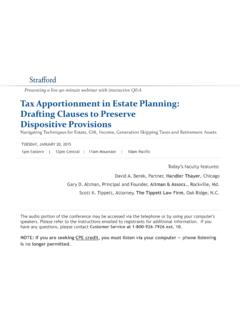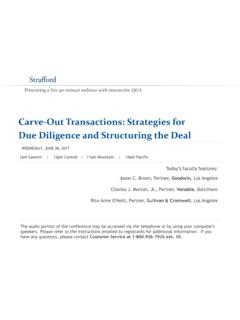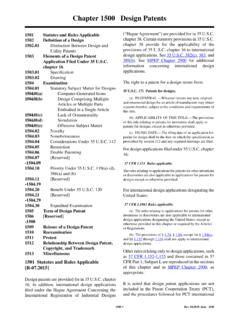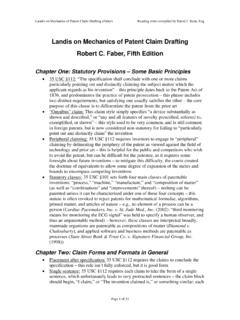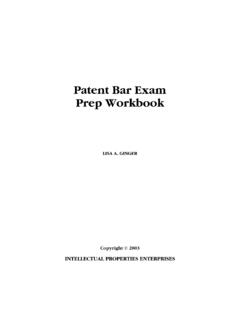Transcription of Means-Plus-Function Patent Claims After the AIA
1 Presenting a live 90-minute webinar with interactive Q&A. Means-Plus-Function Patent Claims After the AIA. Assessing Benefits and Risks, Surviving AIA's PGRs, IPRs and Reissue MONDAY, DECEMBER 16, 2013. 1pm Eastern | 12pm Central | 11am Mountain | 10am Pacific Today's faculty features: Thomas L. Irving, Partner, Finnegan Henderson Farabow Garrett & Dunner, Washington, John Mulcahy, Finnegan Henderson Farabow Garrett & Dunner, Reston, Va. Dr. Amanda Murphy, Finnegan Henderson Farabow Garrett & Dunner, Washington, Wanli Tang, Finnegan Henderson Farabow Garrett & Dunner, Washington, The audio portion of the conference may be accessed via the telephone or by using your computer's speakers. Please refer to the instructions emailed to registrants for additional information.
2 If you have any questions, please contact Customer Service at 1-800-926-7926 ext. 10. FOR LIVE EVENT ONLY. Sound Quality If you are listening via your computer speakers, please note that the quality of your sound will vary depending on the speed and quality of your internet connection. If the sound quality is not satisfactory, you may listen via the phone: dial 1-888-601-3873 and enter your PIN when prompted. Otherwise, please send us a chat or e-mail immediately so we can address the problem. If you dialed in and have any difficulties during the call, press *0 for assistance. Viewing Quality To maximize your screen, press the F11 key on your keyboard. To exit full screen, press the F11 key again. FOR LIVE EVENT ONLY. For CLE purposes, please let us know how many people are listening at your location by completing each of the following steps: In the chat box, type (1) your company name and (2) the number of attendees at your location Click the word balloon button to send Leveraging Means plus Function Patent Claims After the AIA.
3 Assessing Benefits and Risks;. Surviving AIA's PGRs, IPRs and Reissue John Mulcahy, Amanda Murphy, Wanli Tang, and Tom Irving December 16, 2013. 4. Disclaimer All information presented in this course is solely for educational and entertainment purposes to contribute to the understanding of American intellectual property law. The materials reflect only the personal views of the authors and are not attributable to FINNEGAN or its clients. Legal determinations and advice are fact specific, while the information presented in this course is generalized. Therefore, nothing presented in this course should be relied upon as specific legal advice. The presentation of these materials does not establish any form of attorney-client relationship with the authors or FINNEGAN.
4 While every attempt was made to insure that these materials are accurate, errors or omissions may be contained therein, for which any liability is disclaimed. 5. 35 112, paragraph 6 (f). ELEMENT IN claim FOR A COMBINATION.. An element in a claim for a combination may be expressed as a means or step for performing a specified function without the recital of structure, material, or acts in support thereof, and such claim shall be construed to cover the corresponding structure, material, or acts described in the specification and equivalents thereof. 6. Why was 112, 6 Included in the 1952 Act? In re Donaldson (16 1189 (Fed. Cir. 1994)(en banc)) Judge Rich stated: The record is clear on why paragraph six was enacted. In Halliburton Oil Well Cementing Co.
5 V. Walker, 329 1, 67 6, 91 3 (1946), the Supreme Court held that Means-Plus-Function language could not be employed at the exact point of novelty in a combination claim . Congress enacted paragraph six, originally paragraph three, to statutorily overrule that holding. 7. How Does the USPTO Construe 112, 6 (f)? MPEP. : Plain Meaning: **When an element is claimed using language falling under the scope of 35 112, 6th paragraph .. the specification must be consulted to determine the structure, material, or acts corresponding to the function recited in the claim . 2114: It should be noted, however, that means plus function limitations are met by structures which are equivalent to the corresponding structures recited in the specification. [citations omitted].
6 8. How Do You Set Up 112, 6 (f), Claims at the PTO? MPEP 2181(I) provides a template: A claim limitation should be interpreted according to 112(f) if it meets the following 3- prong analysis: A. The claim limitation uses the terms means or step . or a non-structural term that is simply a substitute for the term means for' ( nonce word );. B. The term means for or step for or the nonstructural term is modified by functional language; and C. The phrase is not modified by sufficient structure or material for performing the claimed function 9. MPEP 2181 PTO Only Interprets Means or Step Performing Recited Function Under 112, 6 (f). It is necessary to decide on an element by element basis whether 112, 6 (f), applies. Not all terms in a means- plus function or step- plus -function clause are limited to what is disclosed in the written description and equivalents thereof.
7 112, 6 (f), applies only to the interpretation of the means or step that performs the recited function. 10. MPEP 2181: 112, 6 (f). Claims Must Satisfy 112, 2 (b). 112, 6, states that a claim limitation expressed in Means-Plus-Function language shall be construed to cover the corresponding structure described in the specification and equivalents thereof.. If one employs means plus function language in a claim , one must set forth in the specification an adequate disclosure showing what is meant by that language. If an applicant fails to set forth an adequate disclosure, the applicant has in effect failed to particularly point out and distinctly claim the invention as required by the second paragraph of section 112.. 11. MPEP 2181: How to Satisfy 112, 2 (b).
8 The proper test for meeting the definiteness requirement is that the corresponding structure (or material or acts) of a means (or step)- plus function limitation must be disclosed in the specification itself in a way that one skilled in the art will understand what structure (or material or acts) will perform the recited function. 12. MPEP 2181: Link Material to Function In a 112, 6 (f), claim to Satisfy 112, 1 (a). Structure disclosed in the specification is corresponding structure only if the specification or prosecution history clearly links or associates that structure to the function recited in the claim . This duty to link structure to function is the quid pro quo for employing 112, paragraph 6. 13. MPEP 2181: No Single Means Clause Claims A single means claim does not comply with the enablement requirement of 112, 1, and is not a proper 112, 6 claim .
9 14. Use Of Means plus Function Claims : Variation in Different Technologies A. Mechanical B. Electrical C. Food and chemical formulation technology D. Pharma 15. Functional Claiming Part and parcel of Claims to computer- implemented inventions. Currently, not often tied to disclosed means (algorithm). Difficult to examine. Difficult to locate in clearance search. Breadth frequently exploited by PAEs. 16. Functional Claiming: New Examination Guidelines 17. Emphasis on the Record Clarify the record to establish a clear foundation for claim interpretation, to benefit the examiner, the applicant, and the public Clarify broadest reasonable interpretation . Place Applicant on notice of the Office's position, enabling a more effective response Facilitate post-grant analysis of claim scope 18.
10 Emphasis on the Record The record should be clarified with the 3- prong of MPEP 2181 analysis when: A claim uses the word means and 112(f). is not invoked Not modified by functional language Includes sufficient structure or material for achieving the specified function A claim uses a generic placeholder instead of the word means and 112(f) is invoked. 19. Prong A. Prong A presumptions: The term means with functional language is rebuttably presumed to invoke 112(f). Rebutted when the claim recites sufficient structure to entirely perform the recited function. In absence of the term means, functional language is rebuttably presumed not to invoke 112(f). May be rebutted when the claim element recites a generic placeholder ( nonce word ) for structure/material.






